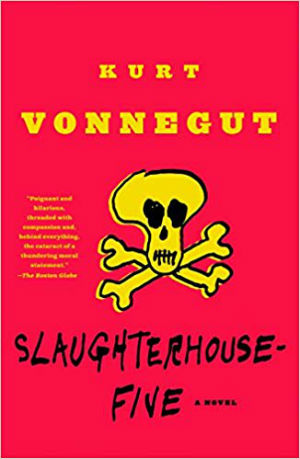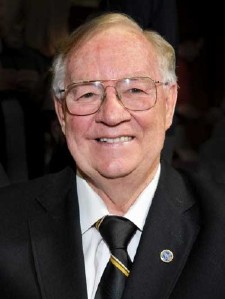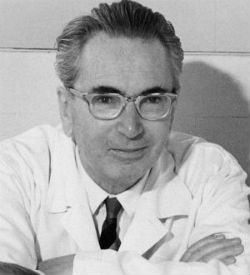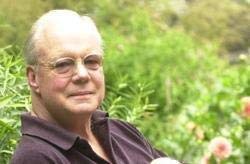‘Slaughterhouse Five’ Reread for the Era of PTSD
By Neil Earle

“Billy Pilgrim has come unstuck in time.” This simple declarative sentence takes readers of Kurt Vonnegut’s Slaughterhouse Five inside the mind of one of the most fascinating characters in American post-World War Two fiction.
Vonnegut’s own personal inciting event was, as is well known, the massacre of the German city of Dresden in February, 1945 and the gruesome after-effects of war, any war, we are now learning. What is immediately significant about Slaughterhouse Five and Billy Pilgrim is that Vonnegut bears witness in this work to the fact that PTSD (Post Traumatic Stress Treatment) has been around for generations. The few survivors from World War Two in the 2000s were quoted on PBS that the 1941-1945 conflict was more “the necessary war” than “the last good war.”
This revisionism hits home with jarring effect as military transports ferry back to American shores the severely traumatized victims of ongoing operations in the Middle East and Canada’s transformation of Ontario’s 401 highway into the Highway of Heroes just 10-15 years ago.
“Narrative Therapy”
The January-February 2018 Discover magazine reported on the FDA’s reconsideration of MDMA – a primary ingredient in ecstasy – as a possible treatment. Here we argue for the use of literature as partial contribution to recovery since PTSD seems to be setting off Slaughterhouse Five’s depictions of Billy’s fantasy voyages to the planet Tralfamadore as counterpoint to the erratic trajectory of his sad winding path through post-war life. Vonnegut may have done the culture a favor by creating a superb literary portrait of the very archetype of the walking wounded – Billy Pilgrim. Vonnegut’s trademark wryness offers a bemused portrait of a man becoming psychologically disoriented from experiencing griefs simply too great to be borne. This is a theme in Western literature that could be traced back to the “heart-devouring anger” of Achilles over a close friend’s death in Book IX of The Iliad (Fagles, 138) and the almost spastic (for the Bible) “Lament” for David over Jonathan in Samuel-Kings. PTSD is just that ancient (LaSor, 180).
 Kurt Vonnegut
Kurt VonnegutThis latent sub-text inside Slaughterhouse Five lends support from analyses reached from two of the clearest-communicating psychologists of the late 20th Century, Dr. M. Scott Peck, author of The Road Less Traveled and Dr. Viktor Frankl in Man’s Search for Meaning. First, let’s harden our definitions: Exactly what is Post-Traumatic Stress Disorder (PTSD)?
Altering Brian Chemistry
At its simplest, PTSD is, in the words of Dr. Robert Ursano of the Uniformed Services University of the Health Sciences located in Bethesda, Maryland – the U.S. military’s medical school – an “event-related disorder brought on by traumas ranging from rape to serious motor vehicle accidents” (Dentzer). The stress levels involved are so intense that in many cases brain chemistry is altered, a condition which leaves behind nightmares, anxiety, social withdrawal, and depression. It is estimated that one in eight returning Iraqi veterans are so afflicted (MSNBC). PTSD has been called many things over the centuries – “soldier’s heart,” nostalgia, shell-shock, combat fatigue. The stark and all-consuming pathology involves intensely painful flashbacks to the precipitating event.
Journalist Susan Dentzer’s interview with Clide Judy in Morgantown, West Virginia was illustrative. Judy was an air force pilot in WW2 on a plane whose engines failed off the coast of Yugoslavia. One crew member’s chute didn’t open; another fell into the sea to be (possibly) eaten by sharks. Judy was rescued by the Navy but still sees the faces of those lost comrades. Vietnam-era veteran Jim Kirchmar’s flashbacks involve speeding down the highway and worrying his wife to death when he relives his waking nightmare of being ambushed in Vietnam. Then there are the anecdotal cases of veterans of kamikaze attacks in 1945 needing their wives to hold them at night during the horrific nightmares lasting for years.
 The bombing of Dresden, Germany in 1945 killed 135,000 people.
The bombing of Dresden, Germany in 1945 killed 135,000 people.To the Planet Tralfamadore
Vonnegut refers to Billy’s “constant state of stage fright…he never knows what part of his life he is going to have to act in next” (Vonnegut, 23). The tell-tale signs of PTSD are almost laconically narrated across Slaughterhouse Five’s chapters two and three. They include:
How does Vonnegut get all this obsessive-compulsive, manic-depressive detail down so well? He’s been there. He’s been to the front and back. His experience of emerging from a slaughterhouse in the city of Dresden, which ironically protected him from the Allied fire-bombing that killed 135,000 people the night of February 13-14, 1945, is the trigger. The casualties were so high that night they surpassed both the fire-bombing of Tokyo (83,793 dead) and the atomic blast on Hiroshima with 71,379 deaths (Vonnegut, 188). The dead were burnt by the German survivors with flame-throwers before disease consumed the rest of the city.
These are searing encounters. To emerge from an underground bunker and to view that carnage is information overload! “Tilt!” goes the mind which whirrs like the hands of a clock in some cartoon fantasy sequence as it tries to process and stabilize itself. Hence Billy’s spaced-out behavior, the use of sexuality as a sedative or escape, the obsessive concern with exceedingly narrow interests, the sci-fi travels to Tralfamadore. And so it goes.
The Inciting Event
The onset of Billy’s PTSD had already been prefigured by his imaginary daydreams on the wet and soggy days as part of a dazed American unit behind the German lines in December, 1944. Vonnegut himself was taken prisoner by the Germans during the cold hell of the Battle of the Bulge in 1944. “That is when Billy first became unstuck in time” (Vonnegut, 30-31). Popular memory wants to incarnate the Bulge as a heroic American Thermopylae, holding out while the German panzers swirl around them (Sulzberger, 524-525). Heroism there surely was, but Vonnegut has what the British call “the poor bloody infantry” perspective. The text describes Billy as a “dazed wanderer” along with three other G.I.s caught behind enemy lines. Vonnegut’s prose begins to dance in these descriptions, even if it is a danse macabre. The guns, writes the author, “make a ripping sound like the opening zipper on the fly of God Almighty.” The profane undercutting is another method of mental and emotional coping – horror outside partly deflected by the retaliatory affect of language coming from inside. Language is one of the few things men in combat still have control over, the voice or recording camera inside their heads taking it all in and yearning for expression. Is this one reason why so many combat veterans are legendarily profane?
 Archibald Hart
Archibald Hart“Thrilled to Death”
Billy’s unit is “led” by the would-be John Wayne of the outfit, Roland Weary, who expatiates with great delight on such gruesome phrases as “the blood gutter,” that shallow groove in the side of the blade of a sword or bayonet. How harsh and grating to civilized civilian ears! Vonnegut catches the exquisite details because in times of extreme combat or deathly peril the recording device inside the mind goes into over-drive. He is setting down his own intense traumas as a POW. This is incarnated in such phrases as “the walnut stocks” of the rifles, the “lethal bee that buzzed past his ear” and the soldiers’ blood “turning the snow to the color of raspberry sherbet.” Beautifully, lyrical and yet hideous – verbal snapshots from a time of horror recollected in tranquility.
But it’s hard to come back from the gates of hell. We civilians can relate to snatches of that encounter with split-second danger, either on the freeway or being surprised from behind – the blood pounding in your ears, the clutching breath, the feeling that your nervous system has been traveling at cyber speed. My own experience of January 1, 2005 when my fine old navy veteran father-in-law – who never spoke of his nightmarish days and nights in the boiler room of the destroyer USS Stanly at Leyte Gulf and elsewhere – passed away from stomach cancer in the next room. He died painfully, but quickly, in the final trauma after a previous night’s suffering in agony. Combat veterans say it is all so much more intense because the danger seems to be coming at you with the force and speed of an express train. Time freezes as your death seems to approach.
Psychologist Archibald Hart has a phrase for the affects of this: anhedonia. The reference is to the pursuit of or the experiencing of exciting stimulation that revs up the nervous system and adrenalizes the overdrive capabilities of the body’s defense mechanisms. Hart refers to it as a “being thrilled to death.” The result is often an apathy or numbness to the routine or more mundane stress of normal life. Cue Billy Pilgrim driving his daughter to distraction. Says Hart: “The recent spate of sexual-acting out behavior of some top Christian leaders is an example of what can happen when one is ‘thrilled to death’” (Hart, 7). Cue Billy Pilgrim and Montana Wildhack having wild and crazy sex in the Tralfamadorian experimental zoo.
Searching for Stasis
Billy’s PTSD/anhedonia sets him up for complete mental illness. After his discharge in 1945, Billy was given the prescription of the moment: shock therapy at Lake Placid then sent home. “He married his fiancée, finished his education and was set up in business in Ilium by his father-in-law” (Vonnegut, 24). This was coping of a sort, a common pattern more harshly reminiscent of the returning warriors depicted in the 1946 film, The Best Years of Our Lives. Billy’s catalogue of misadventures shows that he was falling apart inside. Yet the mind somehow still wants to work towards stasis, some kind of healing. The poet Shelley was no psychiatrist yet he diagnosed better than he knew when he creatively misquoted John Milton’s famous line from Satan in Paradise Lost: “The mind is its own place, and of itself can make a heaven of hell, a hell of heaven” (Shelley, 874).
Paradoxically this is testimony to the power of literature to heal as well as probe. It undergirds Conor Cruise O’Brien’s summation in The Suspecting Glance: “The study of literature is a social science. It is concerned with the results of the most far-reaching and subtle investigations that have been made into man’s mind and passions and his life in society…” (O’Brien). What Vonnegut sets down so well in Slaughterhouse Five is his protagonist’s attempt to find some kind of healing. The mind seemingly never stops processing, tabulating, assimilating and reformulating the bytes of information it has had forcefully imposed on it.
Billy Pilgrim gives testimony to that. Though presented as a fantasy element in the novel, the Tralfamadorians have some good insights, the advantage of the other-worldly perspective. In Billy’s reportage, they see Time horizontally “the way we can look at a stretch of the Rocky Mountains.” From this perspective, Billy breathlessly concludes, all of life’s moments are “permanent” and they can look at “any moment that interests them.” This approach outflanks Death, according to Billy. “When a Tralfamadorian sees a corpse, all he thinks is that the dead person in is in bad condition in that particular moment but that the same person is just fine in plenty of other moments” (Vonnegut, 27). That, at least, is one way out, one way to process carnage, to perhaps mitigate slightly griefs simply too great to be borne, if only temporarily.
 Viktor Frankl
Viktor Frankl“The Talking Cure”
In counseling, we are told, it is important to listen to the counselee’s stories. “The talking cure.” Freudians see stories as dressed up fantasies that the mind has created to throw a screen over reality or deflect it momentarily. “Where would we be without repression?” a UCLA professor of literature asked. A good counselor doesn’t stop there, however. Allowing plenty of time he or she must, if possible, enter the counselee’s trauma and try to disentangle the inciting event. If possible, the nest step is to replace it with other, better thoughts. The only way to get air out of a bottle is to pour something else in. A therapist trained by Dr. Viktor Frankl might proceed thus.
“You escaped. You made it.”
“Yes, but other guys didn’t.”
“True, but now try to make their sacrifices mean something. Redeem their humanity, their nobility. Use their memory as a springboard to ‘redeem the time.’”
That is one way forward, just possibly. The strategy is to enter Billy’s world and try to lift him out of it, to try to create a sense of purpose from the materials of chaos.
Neurosis and Suffering
The popular psychologist, Scott Peck, who learned his trade on army posts, incidentally, showed why the attempt must be made to restore balance to the traumatized psyche.
In the succinctly elegant words of Carl Jung: “Neurosis is always a substitute for legitimate suffering.” But the substitute itself ultimately becomes more painful than the legitimate suffering it was designed to avoid. The neurosis itself becomes the bigger problem. True to form, many will then attempt to avoid this pain and this problem in turn, building layer upon layer of neurosis (Peck, 17).
 Scott Peck
Scott PeckAs simplistic as this first may seem, the road to recovery must begin somewhere. The sympathetic counselor will always be checking her own assumptions and stand ready to change course if the diagnosis isn’t accurate. From diagnosis it is possible to move very carefully to prescription. Note how Peck’s insight fits Billy Pilgrim. “[W]hen we avoid the legitimate suffering that results from dealing with problems, we also avoid the growth that problems demand from us. It is for this reason that in chronic mental illness we stop growing, we become stuck. And without healing, the human spirit begins to shrivel” (Peck, 17).
“We become stuck.” There is Vonnegut’s opening line.
Dr. Viktor Frankl moved beyond Peck. Frankl was an Austrian psychotherapist considered the founder of the “third Viennese School” after Freud and Adler. His philosophy, too, seemed deceptively simple. “Everything can be taken from a man or a woman but one thing,” wrote Frankl, “The last of human freedoms [is] to chose one’s attitude in any given set of circumstances, to choose one’s way” (Frankl, passim). Frankl had an uncanny success rate with suicidal patients in the years before World War Two. His theories were ultimately tested in the grimmest laboratory imaginable: Auschwitz concentration camp. Even from there he emerged more convinced than ever of a key fact of the human experience: “A human being is a deciding being.” We become stuck, says Peck, and becoming stuck in time is one reaction formation to the death-dealing blows life levels at us. This is one reason compassion is so important. As Peck might have added, miming the interior dialogue of the patient: If someone is willing to suffer with me then perhaps suffering is not the worst thing that could happen. Perhaps suffering has a purpose (Brueggemann, 144). “Suffering is in some mysterious way, enobling,” was a Martin Luther King standard.
Hopeful Signs
These insights begin to close the circle a little. Vet Centers are springing up across the country. Some are beginning to realize that severely traumatized victims need to get together to see that they are not alone, to see others who have experienced legitimate suffering, and to check and revise what Peck calls “their maps of reality.” By way of a conclusion, one could do worse than recommend a rereading of Slaughterhouse Five as part of the treatment. The clever Vonnegut, humanist to the end, has Billy Pilgrim construct the best possible life he can in the face of the apathy and incomprehension around him. “Nobody else suspected that he was going crazy. Everybody else thought he looked fine and was acting fine” (Vonnegut, 100). The human being is a deciding animal. Billy has the sense, at least, to check himself into the mental ward where he is introduced to the writings of science fantasy writer Kilgore Trout. Trout’s titles open his mind to the possibility of time travel as well as space travel, including his fantasy visits with Montana Wildhack, supposedly a fellow abductee of the Tralfamadorians. The human propensity to construct counter-reality is a significant part of this novel.
Arguably, this escapist fantasizing is not the way Peck or Frankl or the Mental Health Association would have wanted Billy to develop. The patient, however, at least showed the life signs of busily trying to construct coping mechanisms for his malady.
At an almost quixotic level, Billy was trying to decide an alternate future. Coping? Yes. Somehow in the middle of it all Billy is able to become as “rich as Croesus,” marry an adoring wife, have five optometrists working for him and invest in Holiday Inns and Tastee-Freeze stands. Only his doctor knows the sad, sad truth: “Every so often, for no apparent reason, Billy Pilgrim would find himself weeping. Nobody had ever caught Billy doing it. Only the doctor knew. It was an extremely quiet thing Billy did, and not very moist” (Vonnegut, 61).
There is a poignancy to these words that make the passage a candidate for the quiet emotional center of the book. In a country that has gone on building Holiday Inns and Tastee-Freezes galore, while its wars rage with morbidly increasing frequency, there seems to be a reaction setting in: more time for focused attention on PTSD, more awareness that some are carrying heavy heavy loads. Mass shootings have brought the long-known fact of 1 in 5 Americans and Canadians afflicted with some form of mental illness to public awareness. I first learned that statistic at a CMHA dinner in Regina in 1974 with Buzz Aldrin – second man on the moon – as guest speaker. Aldrin had turned to alcohol after suffering from “the melancholy of all things done,” a phrase from hundreds of years earlier.
There are hopeful signs. There is public space now for public awareness over therapeutic prescriptions for the veterans still suffering from Korea, Vietnam, Desert Storm, Enduring Freedom, Afghanistan. Is this why Vonnegut’s case study seems haunting and prophetic at the same time? Vonnegut has set down in profane but ultimately empathetic prose a fictional case history of what America’s first notable war protestor, Henry David Thoreau, wrote almost two centuries ago: “The mass of men live lives of quiet desperation.”
Literature can help the diagnosis. With that comes the hope of cure.
Works Cited
Brueggemann, Walter. Isaiah 40-66. Louisville: Westminster John Knox Press, 1998. The astute Brueggemann mines this section of Scripture wherein an entire nation is encouraged to mentally prepare to leave behind its Babylonian Captivity. This part of Isaiah is called “the Book of Comfort” (Isaiah 40-66) and militates against the “common insistences that suffering is a dead end with no future and that there is no newness only endless derivations (144).”
Dentzer, Susan. “No Forgetting.” Online NewsHour Posting. 1 June 2007.
Fagles, Robert. “The Iliad, Book IX.” The Norton Anthology of World Masterpieces: The Western Tradition, Volume 1. Eds. Sarah Lawall and Maynard Mack. Seventh ed. New York: W.W. Morton and Company, 1999: 138. “Heart-devouring anger” is opposed to the more famous “rage of Achilles.” The designation for PTSD in the American Civil War was “soldier’s heart.”
Frankl, Viktor E. Man’s Search for Meaning. New York: Washington Square Press, 1985.
Hart, Archibald. “Helping Those Who Help Others.” Fuller Focus 15:2 (2007). 7-9.
LaSor, William Sanford with Hubbard, David Allan and Frederick William Bush. Old Testament Survey: The Message, Form and Background of the Old Testament. Grand Rapids: William B. Eerdmans Publishing Company, 1996.
MSNBC. Online Posting. “1 in 8 returning soldiers suffers from PTSD.” 1 June, 2007.
O’Brien, Connor Cruise. Qtd. in the foreword of Uneasy in Eden: The Wonderful Wizard of Oz in American Popular Culture. Lewiston: Edwin Mellen Press, 1993.
Peck, M. Scott. The Road Less Traveled: A New Psychology of Love, Traditional Values and Spiritual Growth. New York: Simon and Schuster, 1976.
Sulzberger, C.L. and David G. McCullough, eds. The American Heritage Picture History of World War II. New York: Bonanza Books, 1966.
Shelley, Percy Bysshe. “A Defence of Poetry.” The Longman Anthology of British Literature: Volume 2A, The Romantics and Their Contemporaries. Eds. Susan Wolfson and Peter Manning. 3rd. ed. New York: Pearson Education, Inc. 2006. 867-876.
Vonnegut, Kurt. Slaughterhouse Five or The Children’s Crusade: A Duty Dance With Death. New York: Dell, 1991.
Zakaria, Fareed. “Rethinking Iraq: The Way Forward.” Newsweek CXLVIII:19 (November 6, 2006). 26-33.